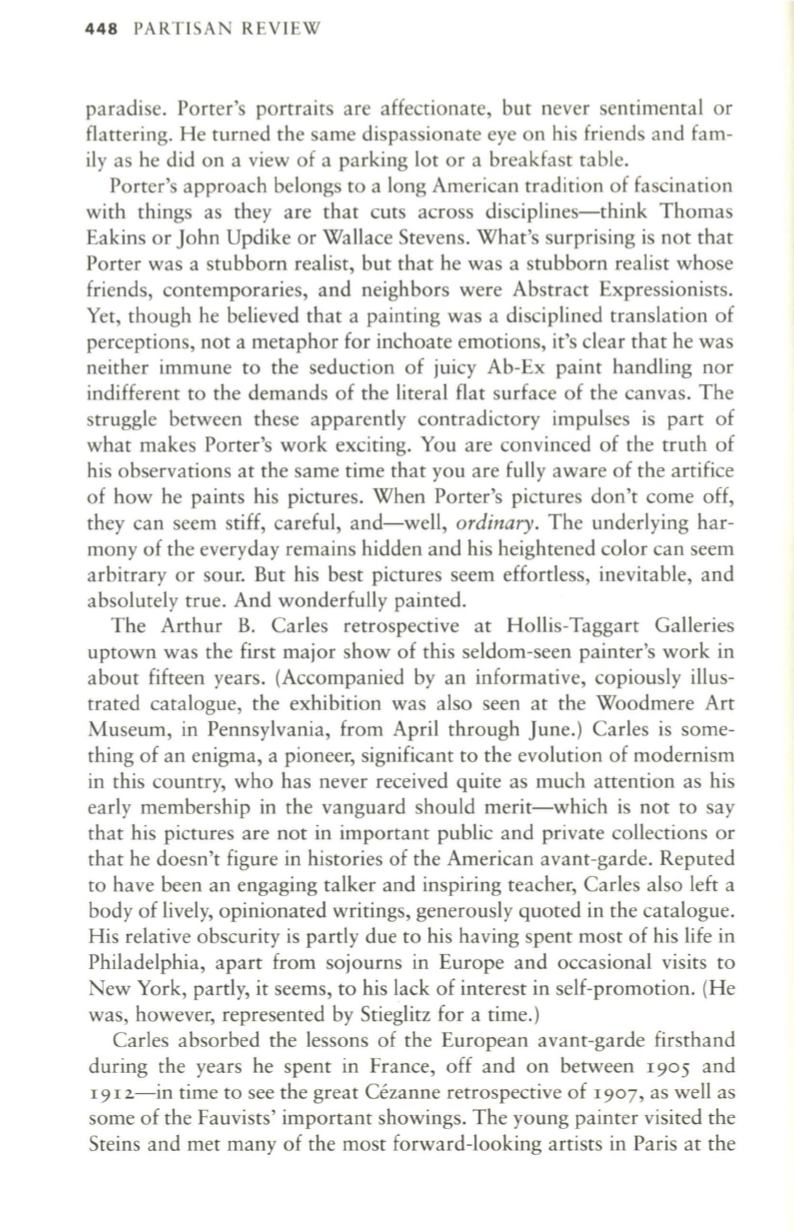
448
PARTISAN REVIEW
paradise. Porter's portraits are affectionate, but never sentimental or
flattering. He turned the same dispassionate eye on his friends and fam–
ily as he did on a view of a parking lot or a breakfast table.
Porter's approach belongs to a long American tradition of fascination
with things as they are that cuts across disciplines-think Thomas
Eakins or John Updike or Wallace Stevens. What's surprising is not that
Porter was a stubborn realist, but that he was a stubborn realist whose
friends, contemporaries, and neighbors were Abstract Expressionists.
Yet, though he believed that a painting was a disciplined translation of
perceptions, not a metaphor for inchoate emotions, it's clear that he was
neither immune to the seduction of juicy Ab-Ex paint handling nor
indifferent to the demands of the literal flat surface of the canvas. The
struggle between these apparently contradictory impulses is part of
what makes Porter's work exciting. You are convinced of the truth of
his observations at the same time that you are fully aware of the artifice
of how he paints his pictures. When Porter's pictures don't come off,
they can seem stiff, careful, and-well,
ordinary.
The underlying har–
mony of the everyday remains hidden and his heightened color can seem
arbitrary or sour. But his best pictures seem effortless, inevitable, and
absolutely true. And wonderfully painted.
The Arthur B. Carles retrospective at Hollis-Taggart Galleries
uptown was the first major show of this seldom-seen painter's work in
about fifteen years. (Accompanied by an informative, copiously illus–
trated catalogue, the exhibition was also seen at the Woodmere Art
Museum, in Pennsylvania, from April through June.) Carles is some–
thing of an enigma, a pioneer, significant to the evolution of modernism
in this country, who has never received quite as much attention as his
early membership in the vanguard should merit-which is not to say
that his pictures are not in important public and private collections or
that he doesn't figure in histories of the American avant-garde. Reputed
to have been an engaging talker and inspiring teacher, Carles also left a
body of lively, opinionated writings, generously quoted in the catalogue.
His relative obscurity is partly due to his having spent most of his life in
Philadelphia, apart from sojourns in Europe and occasional visits to
New York, partly, it seems, to his lack of interest in self-promotion. (He
was, however, represented by Stieglitz for a time.)
Carles absorbed the lessons of the European avant-garde firsthand
during the years he spent in France, off and on between 1905 and
1912-in time to see the great Cezanne retrospective of 1907, as well as
some of the Fauvists' important showings. The young painter visited the
Steins and met many of the most forward-looking artists in Paris at the


